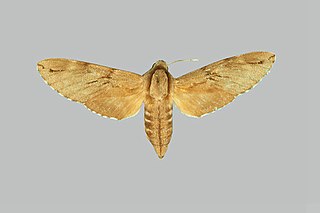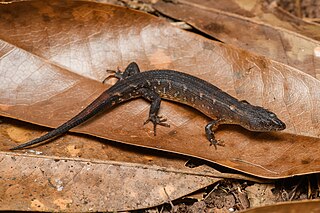Related Research Articles

Calanus is a genus of marine copepod in the family Calanidae. The genus was split in 1974, with some species being placed in a new genus, Neocalanus. The following species are recognised:

The Chinese rufous horseshoe bat is a species of bat in the family Rhinolophidae. It is found in Bhutan, China, India, Nepal, and Vietnam.

Chroniochilus is a genus of flowering plants from the orchid family, Orchidaceae. It contains 5 species, native to Yunnan, Thailand, Malaysia and Indonesia.
Antennoseius sinicus is a species of mite in the family Ascidae.

Sphinx caligineus, the Chinese pine hawkmoth, is a moth of the family Sphingidae. It is known from Japan, north-eastern, eastern, central and southern China, South Korea, northern Thailand and southern Vietnam.
Harpalus sinicus is a species of ground beetle in the subfamily Harpalinae. It was described by Frederick William Hope in 1845.
Ceratophyllus sinicus is a species of flea in the family Ceratophyllidae. It was described by Karl Jordan in 1932.

Rubroboletus sinicus is a bolete fungus in the family Boletaceae. It is found in China. The species was first described by Wei Fan Chiu as Boletus sinicus in 1948, and transferred to the genus Tylopilus in 1979 by Fanglan Tai. In 2014, the genus Rubroboletus was created to accommodate this and allied species.
Nanohammus is a genus of longhorn beetles of the subfamily Lamiinae, containing the following species:

Rubroboletus is a genus of bolete fungi in the family Boletaceae. It was circumscribed by Chinese mycologists in 2014 with Rubroboletus sinicus as the type species. Species are characterized by having a reddish cap surface, yellow tubes on the underside of the cap, and an orange-red to blood-red pore surface. Pinkish to red spots (reticula) are present on the stipe surface, and a bluish color change occurs when the bolete flesh is injured. Rubroboletus mushrooms have an olive-brown spore print, and produce smooth spores. Eight species were included in the original circumscription ; five were added in 2015, and another in 2017.
Nanohammus aberrans is a species of beetle in the family Cerambycidae. It was described by Charles Joseph Gahan in 1894.
Nanohammus alboplagiatus is a species of beetle in the family Cerambycidae. It was described by Stephan von Breuning in 1944. It is known from Malaysia and Borneo.
Nanohammus annulicornis is a species of beetle in the family Cerambycidae. It was described by Maurice Pic in 1934.
Nanohammus grangeri is a species of beetle in the family Cerambycidae. It was described by Stephan von Breuning in 1962. It is known from Vietnam and Laos.
Nanohammus itzingeri is a species of beetle in the family Cerambycidae. It was described by Stephan von Breuning in 1935.
Nanohammus rufescens is a species of beetle in the family Cerambycidae. It was described by Henry Walter Bates in 1884. It is known from Japan.
Nanohammus subfasciatus is a species of beetle in the family Cerambycidae. It was described by Masaki Matsushita in 1941. It is known from Taiwan and Japan.

Astragalus sinicus is a species of milkvetch in the family Fabaceae. It is known under such common names as Chinese milkvetch, renge or genge and is in common use in farming as a green manure. It is not to be confused with Astragalus mongholicus, the plant yielding Radix Astragali for Chinese medicine.
Calanus sinicus is a copepod found in the northwest Pacific.

Tropidophorus sinicus, the Chinese water skink, is a species of skink found in China and Vietnam.
References
- ↑ BioLib.cz - Nanohammus sinicus. Retrieved on 8 September 2014.